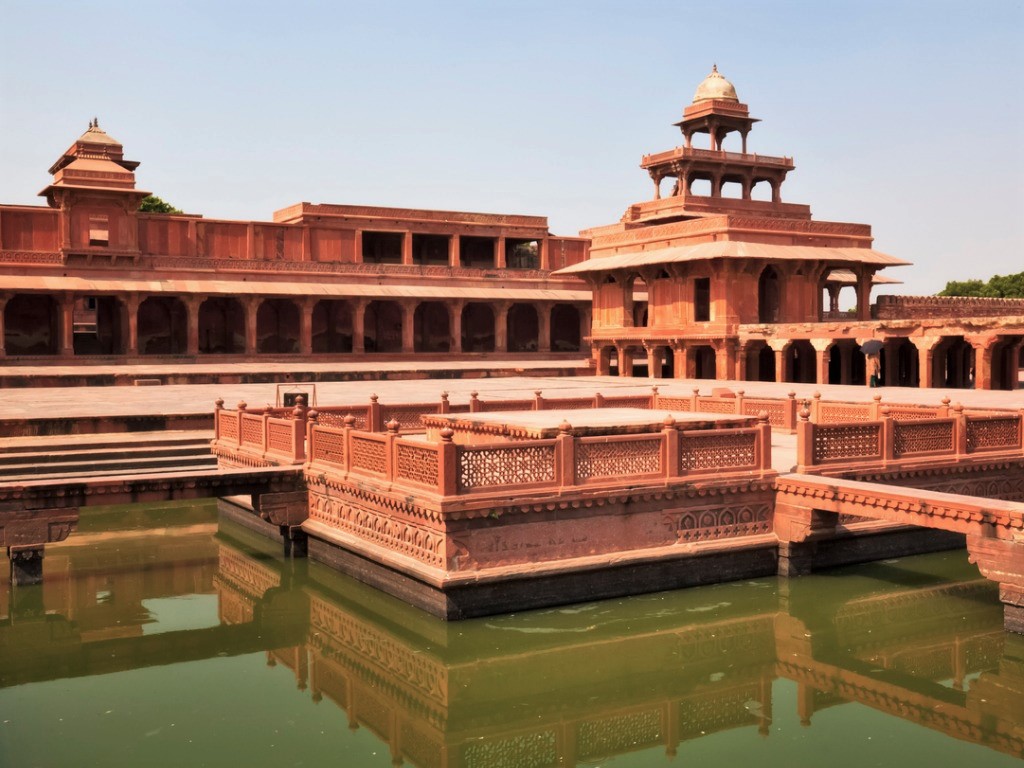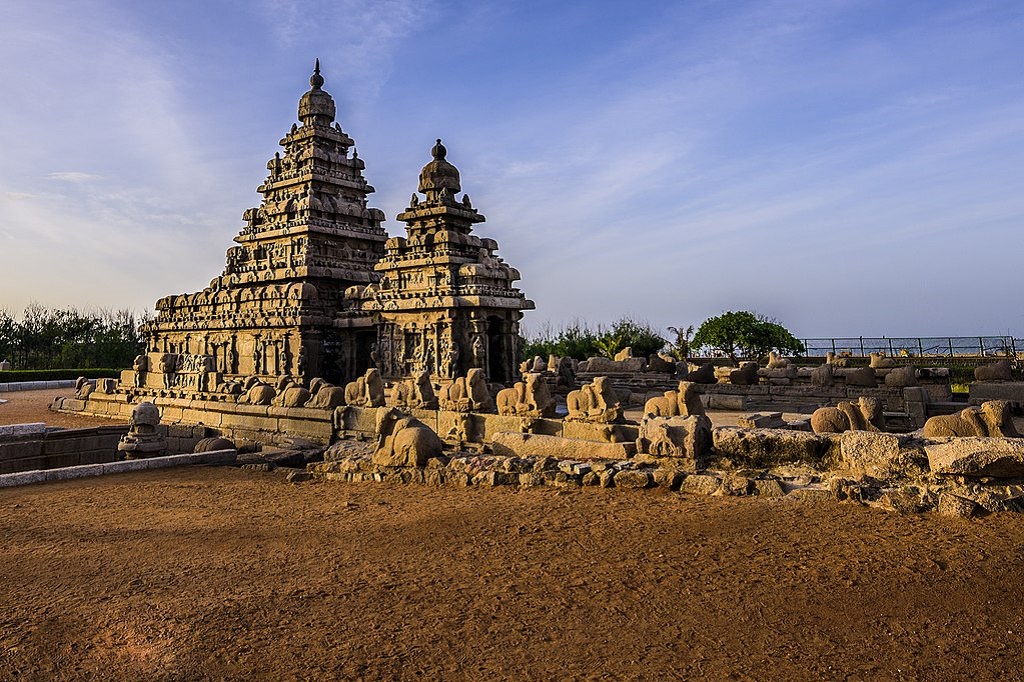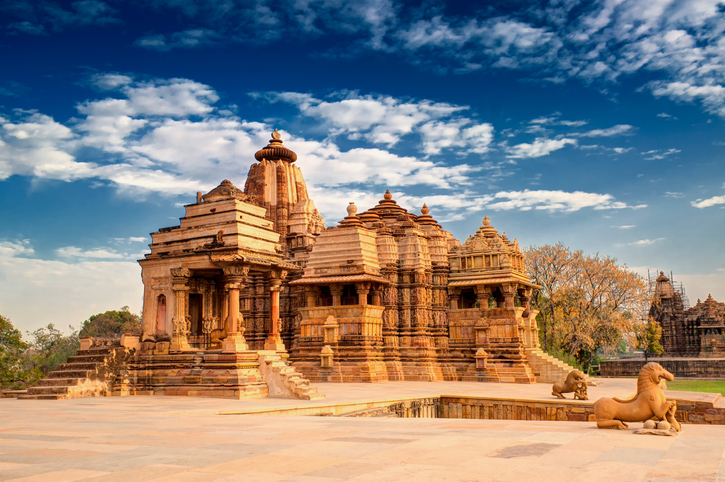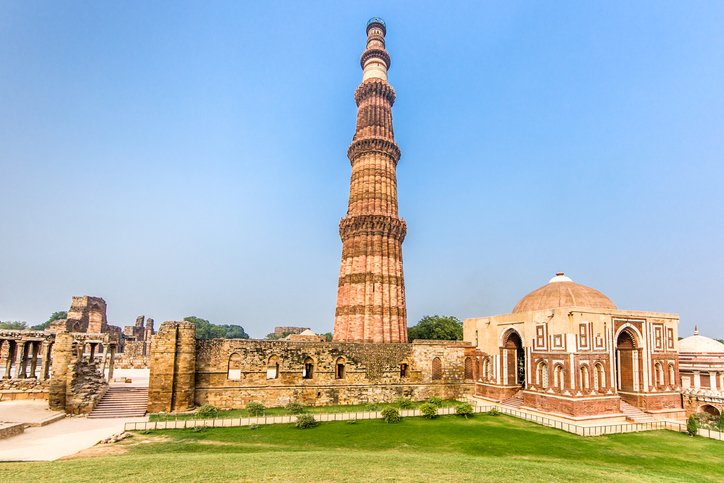India is a country famous for its rich cultural heritage. Here, the present exists almost simultaneously with over 5,000 years of history. Each era and ruler left behind their own architectural legacy, leading to there being scores of marvellous world heritage sites in India.
From ancient temples to imposing Mughal forts and rock-cut Buddhist caves, these iconic historic buildings are a fitting tribute to the country’s complex and varied culture. There are 37 World Heritage Sites in India that are recognised by UNESCO (though 7 are natural), so do try to visit them all.
Cultural World Heritage Sites In India
29Agra Fort, Agra

The red sandstone Agra Fort was built by Emperor Akbar in the 16th century on the banks of River Yamuna. Akbar’s grandson Shah Jahan added to the fort, turning it into a palatial residence, filled with marble palaces, towers, and mosques. However, he was usurped by his son Aurangzeb, and imprisoned here. Legend says that he died in the Muasamman Burj, a tower with a view of his greatest creation, the Taj Mahal.
It was inscribed as a UNESCO World Heritage Site in 1983
28Ajanta Caves, Maharashtra

The Ajanta Caves are some of the most famous in India. They are carved into a hillside near the town of Jalgaon in Maharashtra. The 29 Buddhist caves at Ajanta that date back to the 2nd century BC, with further additions made in the 6th century AD. They are famous for their beautiful art and sculptures, of both deities and abstract designs.
It was inscribed as a UNESCO World Heritage Site in 1983
27Archaeological Site of Nalanda Mahavihara at Nalanda, Bihar

Dating back to the 3rd century BC, the now ruined of Nalanda University was once an educational hub for Buddhist learning. One of the world’s oldest universities, it was sacked by Muslim invaders in the 12th century. Inside the site, you will find stupas, shrines, viharas, and more.
It was inscribed as a UNESCO World Heritage Site in 2016
26Buddhist Monuments at Sanchi, Madhya Pradesh

Sanchi is famous all over the world for its large complex of stupas. The Great Stupa at Sanchi is one of the oldest stone structures in India, dating to the 2nd century BC. It is said to have been commissioned by Emperor Ashoka. In addition to this, the site is full of pillars, temples and monasteries in different states of preservation.
It was inscribed as a UNESCO World Heritage Site in 1989
25Champaner-Pavagadh Archaeological Park, Gujarat

Located in the Panchmahal district of Gujarat, Champaner-Pavagadh was originally built by Sultan Mahmud Begada. The pre-Mughal Islamic city is dotted with forts, palaces, mosques, tombs, and temples. Among these, you will find the crumbling 8th-century Champaner Fort, the Kalikamata Temple and Jain Temple, as well as the Kevda and Nagina Masjid.
It was inscribed as a UNESCO World Heritage Site in 2004
24Chhatrapati Shivaji Terminus, Mumbai

Perhaps the most famous railway station in India, the historic Chhatrapati Shivaji Terminus (formerly known as Victoria Terminus) is one of Mumbai’s most iconic landmarks. It was designed by Frederick William Stevens in the 19th century with a mix of High Victorian Gothic and Indian architectural styles, and officially opened on the day of Queen Victoria’s Golden Jubilee in 1887. The palatial interior sees over 3 million people pass through it each day. The station was later renamed Chhatrapati Shivaji, a famous 17th-century Maratha king.
It was inscribed as a UNESCO World Heritage Site in 2004
Also Read: 22 of the most beautiful Train Stations Around the World
23Churches and Convents of Goa

The southwestern state of Goa is full of churches and convents that were built by the Portuguese who once ruled it as a colony. Dating between the 16th and 18th centuries, there were originally 60 churches, though many eventually fell into ruin. Most can be found in the former capital of Velha Goa. Important churches include the Basilica of Bom Jesus, which has the tomb and relics of St. Francis Xavier, the Sé Catedral de Santa Catarina dedicated to Saint Catherine of Alexandria, the Church and Convent of Saint Francis of Assisi, and the Church of Saint Cajetan and its seminary.
It was inscribed as a UNESCO World Heritage Site in 1986
22Elephanta Caves, Mumbai

The historic Elephanta Caves are located in the Mumbai Harbour, a short ferry ride from the Gateway of India in Mumbai. This group of sculpted five Hindu and two Buddhist cave temples date back to the 5th century AD. While some of the structures may be in ruins, the amazing sculptures, hewn from solid basalt rock, are still a major tourist draw. Don’t miss the majestic three-headed statue of the deity Shiva.
It was inscribed as a UNESCO World Heritage Site in 1987
21Ellora Caves, Maharashtra

Along with the Ajanta Caves, the Ellora Cave Complex is one of the most popular in the country. Carved and sculpted into rock walls of a high basalt cliff near the town of Jalgaon in Maharashtra, the 34 Buddhist, Hindu and Jain caves at Ellora date back to the 6th and 11th centuries AD, and are known for their stunning carvings.
It was inscribed as a UNESCO World Heritage Site in 1983
Also Read: 25 of the Most Famous Caves of India You Have to Visit
20Fatehpur Sikri

Located near Agra, this royal town was founded by Emperor Akbar and served as his capital between 1571 and 1585. It was built to commemorate Akbar’s victory in Gujarat, and, so, it came to be known as Fatehpur Sikri (“City of Victory“). It is full of impressive Mughal buildings, such as the Panch Mahal, the tomb of the Sufi Saint Salim Chishti, the Jama Masjid, and the Buland Darwaza (or “Gate of Magnificence”). However, Fatehpur Sikri was eventually abandoned due to campaigns in Punjab
It was inscribed as a UNESCO World Heritage Site in 1986
19Great Living Chola Temples, Tamil Nadu

Built by kings of the Chola Empire that most stretched over all of Tamil Nadu, the Great Living Chola Temples stand testimony to their achievements architecture. The three temples included are the Brihadesvara Temple at Thanjavur, the Temple of Gangaikonda Cholapuram and the Airavatesvara Temple at Darasuram. They date from the 11th and 12th centuries.
They were inscribed as a UNESCO World Heritage Site in 1987 and 2004
18Group of Monuments at Hampi

Hampi was once the capital of the medieval Vijayanagara empire, whose kings ruled here for over 200 years. It is full of majestic ruins of Hindu temples, palaces, and more that date back to the 14th century. Don’t miss the Virupaksha temple, Vittala temple, and the elephant stables.
It was inscribed as a UNESCO World Heritage Site in 1986
Also Read: What To See and Do When Visiting Hampi
17Group of Monuments at Mahabalipuram, Tamil Nadu

Mahabalipuram, near Chennai, is famous for its amazing temples built by the Pallava kings in the 7th and 8th centuries. The temple town has approximately forty monuments, including the windswept Shore Temple, the Five Rathas temple, and the Arjuna’s Penance rock carvings. The popular beach town is also famous for its surfing.
It was inscribed as a UNESCO World Heritage Site in 1984
16Group of Monuments at Pattadakal, Karnataka

The small villages of Badami, Aihole and Pattadakal, on the banks of Malaprabha River, are known for intricately carved temples, caves and forts, all made from sandstone. They were once a part of the Chalukya Dynasty, which ruled the area between the 6th and 12th century. Pattadakal in particular, is of note, due to its remarkable series of nine Hindu temples. Don’t miss the 8th-century Virupaksha temple of Pattadakal built by Queen Lokamahadevi to commemorate King Vikramaditya II’s victory over the Pallava kings.
It was inscribed as a UNESCO World Heritage Site in 1987
15Hill Forts of Rajasthan

The state of Rajasthan is known for a wide array of historical Hill Forts. Built by the many Rajput kings that ruled this area. Each has its own unique variation of Rajput military hill architecture, using the defensive properties of the hills they sit on. Ride an elephant up the massive ramps of Amer Fort, marvel at the panoramic views from the ramparts of Jaisalmer Fort and Mehrangarh Fort, or get lost in the splendour of Chittor Fort, Kumbhalgarh Fort, Ranthambore Fort, or Gagron Fort.
It was inscribed as a UNESCO World Heritage Site in 2013
14Historic Old City of Ahmadabad, Gujarat

Founded by Sultan Ahmad Shah I in the 15th century, the walled old city of Ahmedabad lies on banks of the Sabarmati River. Its labyrinthine alleyways are full of temples, mosques, and interconnected houses (pols) with ornate wooden facades. Don’t miss the Sidi Saiyad Masjid, with its famous lattice stone windows, and the Bhadra citadel.
It was inscribed as a UNESCO World Heritage Site in 2017
13Humayun’s Tomb, Delhi

Located in Delhi, amidst sprawling gardens, lies the tomb of Humayun – the second Mughal Emperor. The impressive mausoleum was built 14 years after his death by his widow, Hamida Banu Begum, in 1570. Architect Mirak Mirza Ghiyuath was influenced by both local architectures, as well as that of his homeland Persia. Located near the Purana Qila (“Old Fort“), it is one of the earliest examples of a distinct Mughal architectural style.
It was inscribed as a UNESCO World Heritage Site in 1993
12Khajuraho Group of Monuments, Madhya Pradesh

This fascinating group of monuments is attributed to the Chandela dynasty which ruled this area under the sovereignty of Gurjar Pratihars around the 10th century. The monuments display a mix of Hindu and Jain Religious practices at the 22 temples. There is also an outstanding fusion of sculpture and architecture, which can especially be seen at the Kandariya Temple and the Devi Jagdambi Temple.
It was inscribed as a UNESCO World Heritage Site in 1986
11Mahabodhi Temple Complex at Bodh Gaya, Bihar

The Mahabodhi Temple Complex is a Buddhist Monastery that is said to be where Buddha attained enlightenment under the Bodhi tree. Located in Bodh Gaya, this sprawling and serene temple was built by Emperor Ashoka in the 3rd century BC around the famous tree. However, the imposing temple that stands there today goes back to the 5th and 6th centuries AD and is one of the oldest in the country.
It was inscribed as a UNESCO World Heritage Site in 2002
10Mountain Railways of India

Located in the rugged hill regions of the Himalayas of Northern India and the Western Ghats of Southern India, the mountain railways are “outstanding examples of bold, ingenious engineering solutions for the problem of establishing an effective rail link through a rugged, mountainous terrain”. Among those listed are the Darjeeling Himalayan Railway, the Nilgiri Mountain Railway and the Kalka-Shimla Railway. The equally beautiful Matheran Hill Railway is also on the UNESCO tentative list.
They were inscribed as a UNESCO World Heritage Site in 1999,2005, and 2008
9Qutb Minar and its Monuments, Delhi

Located to the south of Delhi, the Qutub Minar complex houses some amazing historical architecture, such as mosques, towers, and tombs that date back to the 13th century. Its most iconic sight is the Qutb Minar, a 238 ft red sandstone tower. Also here are the Alai Darwaza Gate, Qubbat-ul-Islam Mosque (the earliest existing mosque in India), the tomb of Iltumish, and the much older Iron Pillar of Chandra Gupta II.
It was inscribed as a UNESCO World Heritage Site in 1993
8Rani-ki-Vav (the Queen’s Stepwell) at Patan, Gujarat

The intricately carved multi-storey Rani ki Vav is a famous stepwell in the town of Patan. It was built in the 11th-century as a memorial to King Bhimdev I (of the Solanki dynasty) by his wife, Queen Udayamati. There are hundreds of statues dedicated to the Hindu deity Vishnu in his various forms, and to the beautiful Apsaras and Yoginis.
It was inscribed as a UNESCO World Heritage Site in 2014
7Red Fort Complex, Delhi

The Red Fort Complex, also known as Lal Qila, was built by Mughal Emperor Shah Jahan when he decided to move his capital from Agra to Delhi (then known as Shahjahanabad) in 1648. It served as the primary residence of Mughal rulers until the last Emperor, Bahadur Shah Zafar, was exiled by the British in 1857. The fort is filled with beautiful palaces, including the Diwan-I-Am, Diwan-I-Khas, Ranga Mahal, Moti Masjid and the Meena Bazaar.
It was inscribed as a UNESCO World Heritage Site in 2007
6Rock Shelters of Bhimbetka, Madhya Pradesh

Located at the Ratapani Wildlife Sanctuary in Madhya Pradesh, these majestic caves are situated are home to some of the earliest art and rock paintings and carvings in the world. Discovered in 1957, the paintings depict life in the Mesolithic Period, all the way back to 100,000 BC. According to local legend, the Pandavas from the Indian epic tale The Mahabharata are said to have sheltered here.
It was inscribed as a UNESCO World Heritage Site in 2003
5Sun Temple, Konarak, Odisha

The 13th-century Konark Sun Temple was originally built by King Narasimhadeva I of the Eastern Ganga Dynasty. It is famous for being built in the form of the chariot of Surya, the sun god. The chariot 24 wheels and is heavily decorated with stone carvings.
It was inscribed as a UNESCO World Heritage Site in 1984
4Taj Mahal, Agra

Located in the city of Agra, the Taj Mahal is one of the most famous buildings in the world. Often referred to as the crown-jewel of Mughal architecture, the imposing white marble structure was built between 1632 and 1653 as a mausoleum for Emperor Shah Jahan’s wife Mumtaz Mahal. Upon his death, Shah Jahan himself was buried there as well. The white marble structure combines Islamic, Turkish and Persian architectural styles, and is both a UNESCO World Heritage Site and one of the Seven Wonders of the World.
It was inscribed as a UNESCO World Heritage Site in 1983
3The Architectural Work of Le Corbusier, Chandigarh

Charles-Édouard Jeanneret, better known as Le Corbusier, was a Swiss-French architect and designer who is famous for designing buildings across the world. 17 sites of his works, spread over seven countries, comprise what UNESCO terms the “Outstanding Contribution to the Modern Movement”. In India, you can find Le Corbusier’s work in the city of Chandigarh; and especially at the city’s Capitol Complex, High Court, and General Assembly Palace.
It was inscribed as a UNESCO World Heritage Site in 2016
2The Jantar Mantar, Jaipur

The Jantar Mantar is a historical astronomical observatory built by Maharaja Jai Singh in 1728. It is modelled after one he had built in Delhi but is significantly larger. Its 14 structures and 20 fixed instruments measure time, predict eclipses, and track stars. Don’t miss the massive 90 foot Samrat Yantra sundial and the beautifully manicured gardens.
It was inscribed as a UNESCO World Heritage Site in 2010
Also Read: The Top 13 Best Places to Visit in Jaipur This Year
1Victorian Gothic and Art Deco Ensembles of Mumbai

The many Victorian and Art Deco buildings around Marine Drive are a testament to the city’s historic urban heritage. Located to the east of the Oval Maiden in South Mumbai, these include numerous active public buildings; such as the Bombay High Court; Rajabai Clock Tower; Eros Cinema and the University of Mumbai.
It was inscribed as a UNESCO World Heritage Site in 2018
Natural World Heritage Sites In India
Great Himalayan National Park Conservation Area – covering an area of 90,540 hectares in Himachal Pradesh, this area is known for its alpine peaks, meadows and forests filled with flora and fauna.
Kaziranga National Park – located along the Brahmaputra River in the Northeastern state of Assam, this national park covers 42,996 hectares. It is home to the largest population of the great Indian one-horned rhinoceros.

Keoladeo National Park – once a duck-hunting reserve of the Maharajas of Bharatpur, this national park is set amongst Indus-Ganges wetlands. Spread over an area of 2,783 hectares, it is famous for its many species of birds that migrate here during the winter
Khangchendzonga National Park – set amongst the Himalayas in the northern state of Sikkim, this park has spectacular snow-capped mountains covered with ancient forests, glaciers, and the world’s third highest peak, Mount Khangchendzonga

Manas Wildlife Sanctuary – also in Assam, this sanctuary lies in the plains of the Manas River in the foothills of the Himalayas and continues into neighbouring Bhutan. Spread over 50,000 hectares, it is home to several species of endangered plants and animals; including tigers, Indian rhinoceros, wild buffaloes, and the sloth bear.
Nanda Devi and Valley of Flowers National Parks – nestled high in West Himalayas in the Chamoli District of Uttarakhand, this park is famous or its meadows of alpine flowers. The richly diverse area is also home to the snow leopard, the Asiatic black bear and blue sheep.

Sundarbans National Park – this vast unique coastal forest is located in the Bay of Bengal. It is famous for its mangrove forest, which covers over 1,000,000 hectares. Spread across parts of Bangladesh and West Bengal in India, it is home to many protected and endangered species; including the Bengal tiger.
The Western Ghats – spread across the western side of India, this mountain range is one of the world’s ten “Hottest biodiversity hotspots”. There are plenty of national parks, wildlife sanctuaries and reserve forests here; across the states of Kerala, Karnataka, Tamil Nadu and Maharashtra.
Which of these World Heritage Sites in India have you been to? Share your experiences in the comments below.



After reading this my new travel list is ready. Great list, so many beautiful places are listed.
Nice Article!